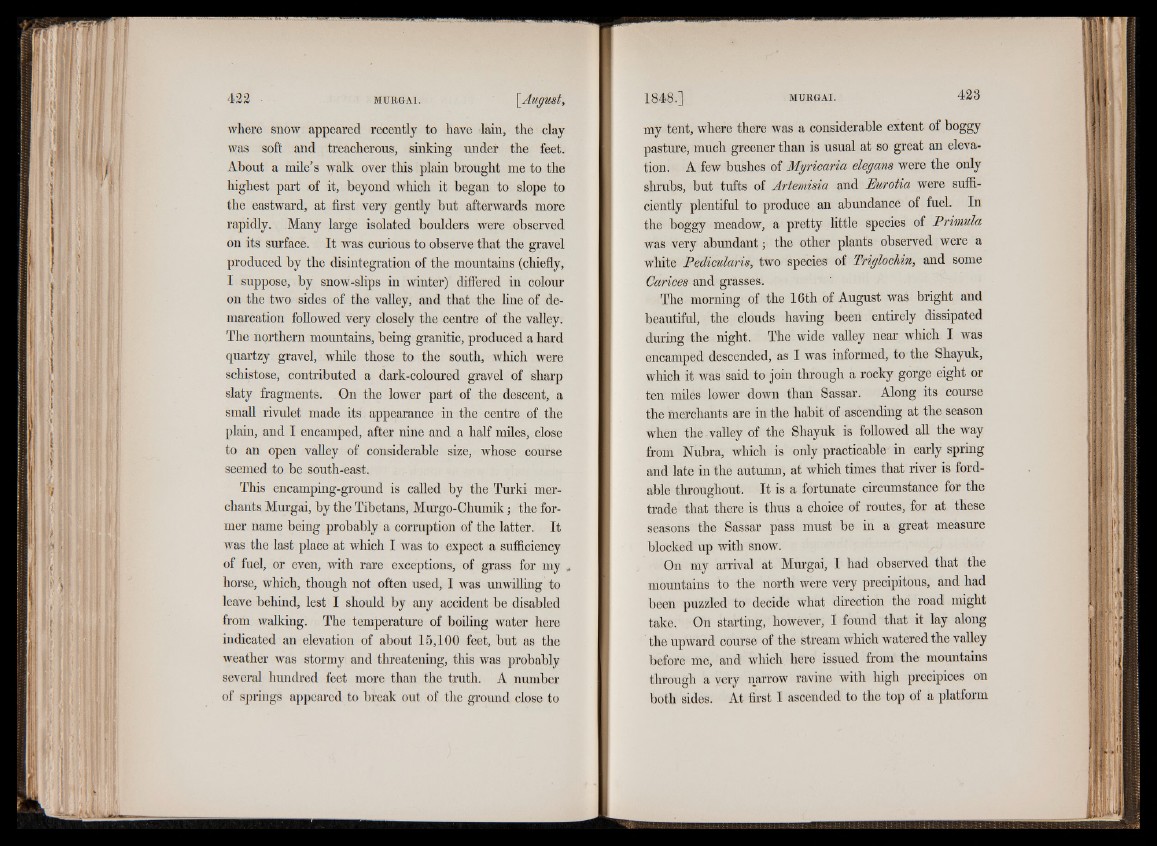
where snow appeared recently to have lain, the clay
was soft and treacherous, sinking under the feet.
About a mile’s walk over this plain brought me to the
highest part of it, beyond which it began to slope to
the eastward, at first very gently but afterwards more
rapidly. Many large isolated boulders were observed
on its surface. It was curious to observe that the gravel
produced by the disintegration of the mountains (chiefly,
I suppose, by snow-slips in winter) differed in colour
on the two sides of the valley, and that the line of demarcation
followed very closely the centre of the valley.
The northern mountains, being granitic, produced a hard
quartzy gravel, while those to the south, which were
schistose, contributed a dark-coloured gravel of sharp
slaty fragments. On the lower part of the descent, a
small rivulet made its appearance in the centre of the
plain, and I encamped, after nine and a half miles, close
to an open valley of considerable size, whose course
seemed to be south-east.
This encamping-ground is called by the Turki merchants
Murgai, by the Tibetans, Murgo-Chumik; the former
name being probably a corruption of the latter. It
was the last place at which I was to expect a sufficiency
of fuel, or even, with rare exceptions, of grass for my
horse, which, though not often used, I was unwilling to
leave behind, lest I should by any accident be disabled
from walking. The temperature of boiling water here
indicated an elevation of about 15,100 feet, but as the
weather was stormy and threatening, this was probably
several hundred feet more than the truth. A number
of springs appeared to break out of the ground close to
my tent, where there was a considerable extent of boggy
pasture, much greener than is usual at so great an elevation.
A few bushes of Myricaria elegans were the only
shrubs, but tufts of Artemisia and Eurotia were sufficiently
plentiful to produce an abundance of fuel. In
the boggy meadow, a pretty little species of Primula
was very abundant; the other plants observed were a
white Pedicularis, two species of Triglochin, and some
Carices and grasses.
The morning of the 16th of August was bright and
beautiful, the clouds having been entirely dissipated
during the night. The wide valley near which I was
encamped descended, as I was informed, to the Shayuk,
which it was said to join through a rocky gorge eight or
ten miles lower down than Sassar. Along its course
the merchants are in the habit of ascending at the season
when the -valley of the Shayuk is followed all the way
from Nubra, which is only practicable in early spring
and late in the autumn, at which times that river is fordable
throughout. It is a fortunate circumstance for the
trade that there is thus a choice of routes, for at these
seasons the Sassar pass must be in a great measure
blocked up with snow.
On my arrival at Murgai, t had observed that the
mountains to the north were very precipitous, and had
been puzzled to decide what direction the road might
take. On starting, however, I found that it lay along
the upward course of the stream which watered the valley
before me, and which here issued from the mountains
through a very narrow ravine with high precipices on
both sides. At first I ascended to the top of a platform